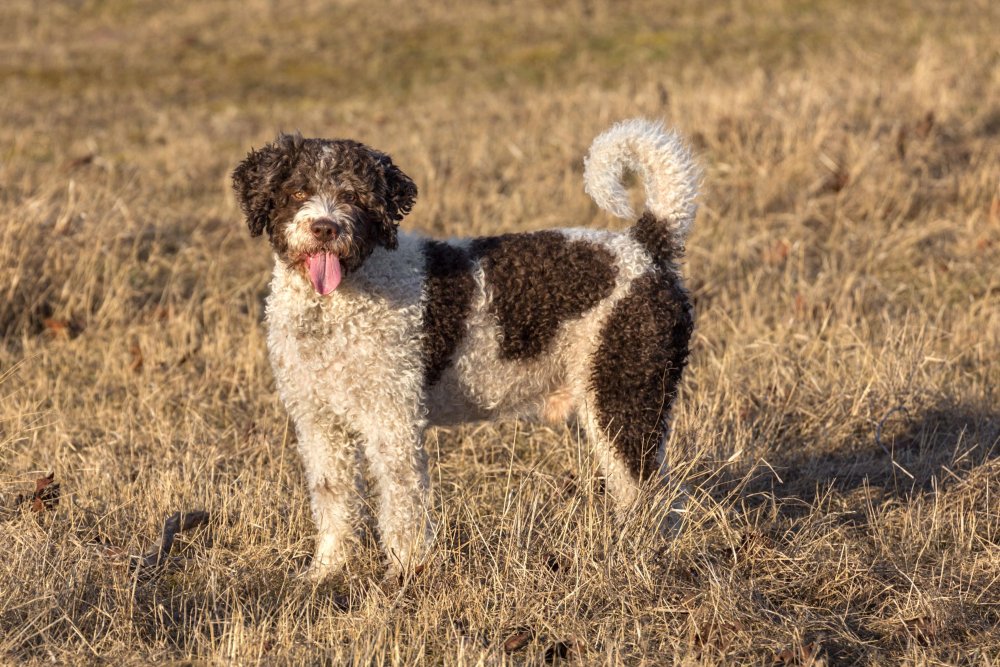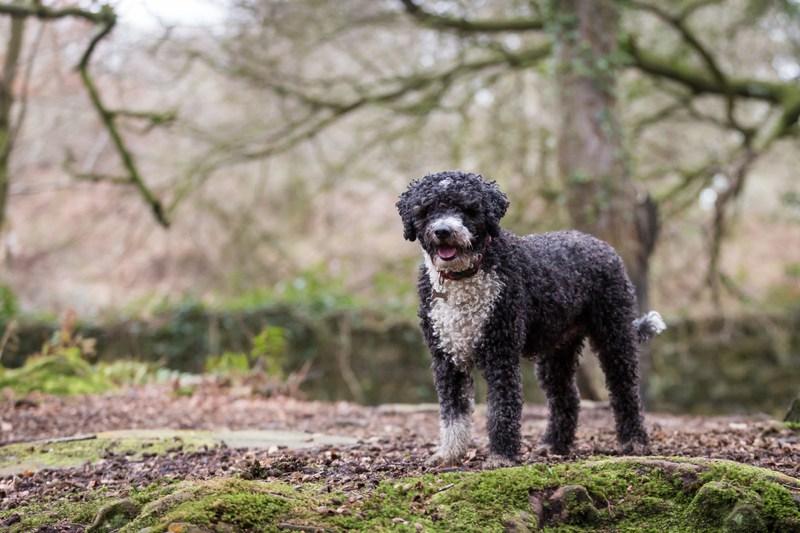- Breed Category: Working Dog
- Country of Origin: Spain
- Average Height: Males 44-50 cm, Females 40-46 cm
- Average Weight: Males 16-20 kg, Females 14-18 kg
- Average Life Span: 12-14 years
- Grooming Requirements: Low, occasional trimming needed
- Exercise Requirements: High, needs daily exercise
- Coat Type: Curly and woolly
- Coat Color Variations: Black, brown, beige, white
- Shedding Level: Low
- Ear Type: Drop ears
- Tail Type: Natural or docked
- Temperament: Loyal, energetic, intelligent
- Intelligence Level: High
- Barking Tendency: Moderate
- Compatibility with Children: Good with proper socialisation
- Compatibility with Other Pets: Generally good
- Training Ease: Relatively easy with consistency
- Common Health Issues: Hip dysplasia, eye disorders
- Dietary Needs: Balanced diet, avoid overfeeding
- Energy Level: High
- Drooling Tendency: Low
- Sensitivity to Weather: Moderate, protect from extreme cold
- Overall Maintenance Level: Moderate
- Original Purpose: Herding and water work
- Year of Recognition by Kennel Clubs: 2005
- Apartment Friendly: Yes, with sufficient exercise
- Best Suited For: Active families, outdoor enthusiasts
- Cost of Ownership: Moderate
- Unique Traits: Hypoallergenic coat, versatile worker
- Cultural Significance: Traditional Spanish herding dog
- Popularity Rank: Growing in popularity
Ever found yourself overwhelmed by the sheer number of dog breeds out there? It’s like trying to pick a favourite chocolate from a box of assorted treats. Each one has its own unique flavour, and the Spanish Water Dog is no exception. This breed is a fascinating mix of energy, intelligence, and loyalty, making it a standout choice for many dog lovers.
Originating from Spain, these dogs were traditionally used for herding and water work. Their curly coats and agile bodies are not just for show; they’re built for action. In this article, we’ll dive into the characteristics that make the Spanish Water Dog special, explore its rich history, and offer tips on how to care for this lively companion.
History and Origin of the Spanish Water Dog

Early Development of the Breed
The Spanish Water Dog has roots that stretch back centuries, with its origins deeply embedded in the Iberian Peninsula. This breed was shaped by the needs of local farmers and fishermen, who required a versatile and hardworking dog. Over time, these dogs developed their distinctive curly coats and robust physiques, perfectly suited for the varied tasks they were expected to perform.
Role in Spanish Herding and Water Work
In the rugged landscapes of Spain, these dogs were indispensable. They excelled in herding sheep and goats across challenging terrains, showcasing their agility and intelligence. But their talents didn’t stop on land. Spanish Water Dogs were also adept at water work, retrieving items and assisting fishermen. Their natural affinity for water made them invaluable in coastal regions.
Key Historical Figures and Regions
The breed’s development is closely linked to regions like Andalusia and the Cantabrian coast, where their skills were most needed. Historical figures, including local shepherds and fishermen, played a crucial role in refining the breed’s characteristics, ensuring that the Spanish Water Dog remained a reliable and versatile companion.
Physical Characteristics of the Spanish Water Dog

Appearance
Spanish Water Dogs are medium-sized, typically weighing between 14 to 22 kilograms and standing about 40 to 50 centimetres tall. Their most striking feature is their curly, woolly coat, which can come in a variety of colours. You might see them in solid shades like black, brown, or white, or even in bicolour combinations. This coat isn’t just for looks; it’s practical, offering protection from harsh weather and water.
Unique Physical Traits
One of the standout traits of the Spanish Water Dog is its coat, which is naturally curly and can form tight cords if left untrimmed. This unique texture is not only eye-catching but also serves a functional purpose, helping the dog stay buoyant and warm in water. Their webbed feet are another fascinating feature, making them excellent swimmers and perfectly suited for their historical roles in water work.
Temperament and Behaviour of the Spanish Water Dog

Typical Personality Traits
Spanish Water Dogs are known for their loyalty, intelligence, and high energy levels. These dogs form strong bonds with their families, often becoming a devoted companion. Their intelligence makes them quick learners, but it also means they need mental stimulation to keep them happy. Without enough activity, they might find their own ways to entertain themselves, which isn’t always ideal.
Suitability as a Family Pet and Working Dog
These dogs are versatile, fitting well into both family and working environments. As family pets, they thrive in active households where they can join in on adventures. Their herding instincts and love for water make them excellent working dogs, too. Whether it’s herding livestock or participating in dog sports, they’re always up for a challenge.
Interaction with Children and Other Animals
Spanish Water Dogs generally get along well with children, especially if they’re raised together. Their playful nature makes them great playmates, but supervision is always a good idea to ensure everyone plays nicely. With other animals, they can be friendly, though early socialisation is key to fostering positive interactions.
Training and Exercise Needs of the Spanish Water Dog

Importance of Early Training and Socialisation
Getting a head start on training and socialisation is crucial for Spanish Water Dogs. These dogs are naturally intelligent and eager to learn, but they need guidance to channel their energy positively. Early exposure to different environments, people, and other animals helps them grow into well-rounded adults. It’s all about setting the foundation for a balanced and happy life.
Recommended Training Techniques
When it comes to training, positive reinforcement is the way to go. These dogs respond well to rewards and praise, making them quick learners. Consistency is key, so regular training sessions will keep them engaged and focused. Incorporating fun activities like agility or obedience games can make learning enjoyable for both you and your dog.
Daily Exercise Requirements and Activities They Enjoy
Spanish Water Dogs are bundles of energy, so daily exercise is a must. They thrive on activities that challenge both their bodies and minds. Long walks, swimming, and interactive play sessions are perfect for keeping them fit and happy. They also enjoy dog sports, which provide an excellent outlet for their natural athleticism and intelligence.
Health and Lifespan of the Spanish Water Dog
Common Health Issues
Spanish Water Dogs are generally healthy, but like any breed, they can be prone to certain health issues. Hip dysplasia is one concern, where the hip joint doesn’t fit together perfectly, potentially leading to arthritis. Progressive Retinal Atrophy (PRA) is another condition to watch for, affecting their vision over time. Regular vet check-ups can help catch these issues early.
Average Lifespan and Health Tips
These dogs typically live between 12 to 14 years. To keep them healthy, a balanced diet and regular exercise are essential. Their energetic nature means they need plenty of physical activity to stay fit and happy. Mental stimulation is just as important, so engage them with puzzles and interactive toys.
Preventative Care Recommendations
- Regular vet visits for health screenings and vaccinations.
- Maintain a healthy weight through a balanced diet and exercise.
- Brush their teeth regularly to prevent dental issues.
- Check their ears for signs of infection, especially if they swim often.
- Groom their coat to prevent matting and skin problems.
Grooming and Maintenance of the Spanish Water Dog
Coat Care and Grooming Routines
The Spanish Water Dog’s curly coat is one of its most distinctive features, but it requires regular attention to keep it in top shape. Unlike some breeds, their coat should not be brushed. Instead, it’s best to let it form natural cords. Regular trimming is essential to prevent matting and maintain a neat appearance. A professional groomer familiar with the breed can be a great help.
Shedding and Seasonal Grooming Tips
These dogs are known for their low-shedding coats, making them a good choice for those who prefer less hair around the house. However, seasonal changes can still affect their coat. During these times, a bit more attention might be needed to manage any loose hair. Bathing should be done only when necessary, using a gentle dog shampoo to avoid stripping natural oils. After a swim, always rinse their coat with fresh water to remove any salt or chlorine, which can be harsh on their skin.
Diet and Nutrition for the Spanish Water Dog

Nutritional Needs for Optimal Health
Feeding your Spanish Water Dog a balanced diet is crucial for their health and vitality. These active dogs need a diet rich in high-quality proteins to support muscle development and energy levels. Look for dog foods that list meat as the first ingredient, ensuring they get the essential amino acids they need.
Foods to Include and Avoid
Include a variety of vegetables and fruits in their diet for vitamins and antioxidants. Carrots, sweet potatoes, and blueberries are great choices. Avoid foods high in fillers like corn and soy, as well as artificial additives. Chocolate, grapes, and onions are toxic to dogs and should be kept out of reach.
Feeding Schedules and Portion Recommendations
Establishing a consistent feeding schedule helps maintain their energy levels and digestive health. Typically, two meals a day are sufficient for adult dogs, while puppies may need three to four smaller meals. Portion sizes depend on their age, weight, and activity level, so consult your vet for tailored advice. Always provide fresh water to keep them hydrated, especially after exercise.
Fun Facts and Trivia about the Spanish Water Dog

Interesting Tidbits about the Breed
Did you know that the Spanish Water Dog is often mistaken for a poodle due to its curly coat? But unlike poodles, their coat is never brushed, allowing it to form natural cords. This unique feature not only gives them a distinctive look but also serves a practical purpose, helping them stay warm and buoyant in water.
Another fun fact is their incredible versatility. Historically, they’ve been used for herding, hunting, and even as search and rescue dogs. Their intelligence and adaptability make them a jack-of-all-trades in the canine world.
Famous Spanish Water Dogs in Media or History
While the Spanish Water Dog might not be as famous as some other breeds, it has made its mark in various fields. In Spain, they are celebrated for their contributions to rural life, particularly in regions like Andalusia. In recent years, their popularity has grown internationally, with appearances in dog shows and competitions showcasing their agility and intelligence.
Final Thoughts

The Spanish Water Dog is a remarkable blend of versatility and loyalty. This breed’s unique characteristics make it an ideal companion for active families and outdoor enthusiasts. With its rich history and distinctive traits, the Spanish Water Dog offers both challenges and rewards, requiring dedicated care and engagement. Embracing this breed means welcoming a lively, intelligent partner into your life, ready for adventures and companionship. Consider adopting a Spanish Water Dog to experience the joy and fulfillment they bring to any household.
